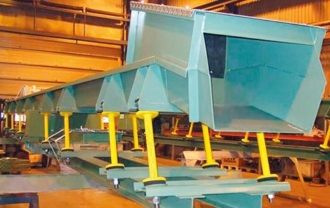The sawmill industry uses a whole range of conveyor solutions. Some of them are tailormade for sawmills.
Conveyor solutions for logs, sawn and planed timber and sawing by-products:
- Chain conveyors
- Scraper conveyors
- Belt conveyors
- Screw conveyors
- Roller conveyors
- Vibrating conveyors
- Vibrating tables
- Elevators
- Tubulators
© Nordautomation Oy
Log table:
- The lateral transfer of logs and sawn timberis mainly done using lateral transfer tables that have purpose-built conveyor chains.
- The tables have several chains side by side set according to the length of the transferred material. The size and model of the chains vary depending on the load and material.
- Log tables need heavy-duty chains while lighter chains are sufficient for planed timber.
- The chains used in the lateral transfer tables are smooth, excluding the log tables that have wide plates welded on the chain loops in order to receive the impacts caused by the bundles of logs falling on the chains.
Features on conveyors:
- A sturdy chain conveyor with lateral V-shaped transfer scrapers is suitable for the longitudinal transfer of logs.
- Scraper conveyors are most commonly used for the transfer of by-products, such as sawdust, bark and chips.
- These conveyors are usually U-shaped steel chutes.
- In the narrower models, the conveyor chain travels in the middle and it has transverse wooden or steel scrapers attached at regular intervals.
- In the wider conveyor chutes, the chains run along the inner edges and the scrapers are located between these.
- Scraper conveyors that carry by-products can be installed horizontally or at an angle so that they descend or ascend.
- Belt conveyors are also very common in sawmills. They are mainly used for transferring sawn and planed timber longitudinally. The belt is located horizontally inside short chutes where the belt runs at the bottom of the chute. The longer versions have rollers below the belt to reduce friction.
- A screw conveyor has a tube or an open chute where a screw with a large diameter turns pushing the material forward. In an open chute model, there can even be two screws side by side for larger quantities of material. In these models, one screw thread is right-handed and the other left-handed so that they turn in different directions. Screw conveyors are mostly used for the transfer of sawdust and chips. The benefit of a screw conveyor is that it does not have a return belt or chain that creates a mess.
- Roller conveyors are designed for the longitudinal transfer of planed timber packages. Roller conveyors generally have a fairly small roller interval, and the rollers are usually turned by a roller chain power transmission. Side transfer chains can be installed between the rollers so that, by lifting the chains, packages can be lifted off the rollers and transferred sideways.
- A vibrating conveyor transfers material by creating an asymmetrical vibrating motion that drives the material forward. A vibrating conveyor has a U-shaped chute similar to the one on scraper conveyors, and the material “jumps” forward at the bottom of the chute. The chute is fixed onto the frame by flexible feet that enable the chute’s constant movement up and forward. At sawmills, vibrating conveyors are most often used as feeders for chippers.
- A vibrating table has a similar structure to a vibrating conveyor, but the table is far wider. The benefit of the vibrating table is that its vibration levels the large material heaps. This makes it ideal as a sideways transfer-type feeder table for a chipper infeed conveyor.
- Elevators are fairly rare in sawmills. They are used when loose material has to be transferred upwards. Elevators can be chain or belt operated. Elevators have lugs or containers fixed on a chain or belt that lift up the material. The chains and belts travel inside upright protective tubes in both directions.
- Tubulator conveyors have a conveyor belt running inside a tube on top of an air cushion. Tubulator conveyors are suitable for transferring chips and sawdust, especially for long distances and if the conveyor is located high off the ground. The enclosed structure keeps the environment clean.







